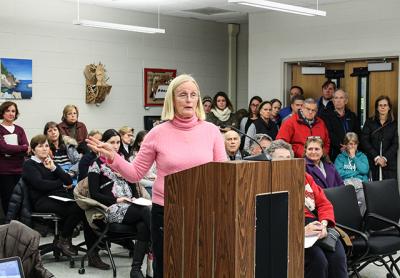Bus Depot Question Incites More Pushback

It was close to standing room only at Tuesday’s meeting of the East Hampton School Board. More than 50 protestors were on hand to continue their fight against the district’s proposed bus maintenance and refueling depot on Cedar Street, even as the school superintendent announced that four commercial landowners had offered sites for the facility, in addition to the possible use of a town-owned property.
All 50 raised their hands when Chuck Collins, a Cedar Street resident, asked who would vote “no” should the school district put forth a proposition to fund a bus depot there. He urged the school board to continue talks with East Hampton Town about the former scavenger waste site on Springs-Fireplace Road, which Supervisor Larry Cantwell has said is on the table.
“Building a bus depot on Cedar Street would hurt the entire town of East Hampton, and is certainly not just a remote issue where only a few people aren’t happy,” Mr. Collins said. “Take a look at the taxpayers whom you represent, and don’t wait to have them vote the bus depot down in May. This is the time to do the right thing.”
Encie Peters, also of Cedar Street, said its residents have opposed the project from day one, and disputed a comment she reportedly heard at a recent PTA meeting suggesting that the opposition to the bus barn was coming from part-time residents.
“We are not second homeowners,” she said. “We are multigenerational families who have been involved in this school district in many different capacities. Traditionally, we are your yes votes, the supporters of this school.”
The school board directed the superintendent, Richard Burns, to meet again with Mr. Cantwell about the former scavenger waste site and to further discuss using the town and village-owned fuel pumps at the town Highway Department, also on Springs-Fireplace Road, to fuel buses, rather than include a fuel pump in the Cedar Street proposal.
The board has not made public the locations of the four commercial properties that were proposed as potential bus depot sites, noting that real estate negotiations are reserved for executive sessions.
Mr. Burns said the district should receive by mid-January a report, required under the State Environmental Quality Review Act, which had emerged as another sticking point among residents at Tuesday’s meeting. Jeff Bragman, an East Hampton attorney who is representing the ad hoc Cedar Street Committee, suggested the district had not followed proper SEQRA procedure.
“We’re going to follow it to the letter of the law,” J.P. Foster, the school board president, said later in the meeting. “Our counsel is advising us, our architect is advising us. . . . That process is and will be followed the way it is supposed to be.”
Also at the meeting, the board ratified an agreement with the district’s teachers giving them a new three-year contract, after 16 negotiation sessions going back to the winter of 2015. The contract, which is dated retroactively to July 1 and runs through June 30, 2019, gives teachers pay raises of .5 percent this year, 1 percent next year, and .75 percent the following year. It shifts a slightly higher share of the cost of health benefits to the teachers and phases out longevity pay after the 2018-19 school year.
Stipends for some department coordinators will increase. Teachers in grades 6 through 12 will see their “student load limit” (the maximum number of students they can teach per day) increased from 128 to 133.
“Throughout the collective bargaining process, both parties acted professionally and collaboratively, made concessions, and shared a dialogue of mutual understanding. . . . The end result is a fair contract that demonstrates fiscal responsibility while rewarding our employees for their skills and dedication to the important and varied roles they play within the East Hampton School District,” Mr. Burns said.
The East Hampton Teachers Association released its own statement: “We believe the three-year agreement that was reached recognizes the fiscal constraints that our school district operates under, as well as acknowledges that we all have an overriding mutuality of interest in the desire to offer the finest possible education for the children of East Hampton, which is consistent with the aspirations of the community.”
Mr. Burns also offered an update on East Hampton’s ongoing legal dispute with Sandpebble Builders, the construction company that sued the district in 2006 claiming that its contract had been wrongfully terminated.
In May, a jury awarded Sandpebble $750,750 in damages, and last week State Supreme Court Judge Jerry Garguilo decided the district should pay 9 percent interest on that amount, dating back to the beginning of the lawsuit. Sandpebble had been seeking $3.7 million plus accrued interest, but the district later countered with a lawsuit of its own to limit the damages.
School officials have said the district has sufficient money available to pay Sandpebble the sum determined by the jury. The district has spent more than $3 million on legal fees alone since the lawsuit began 10 years ago. Mr. Burns said the final amount the district owes is yet to be determined.
